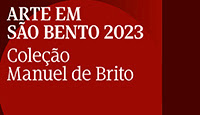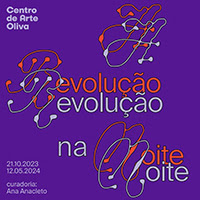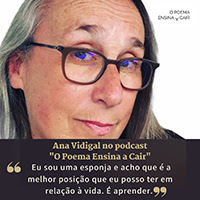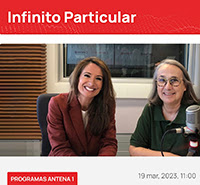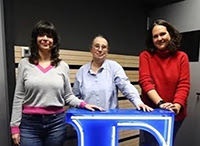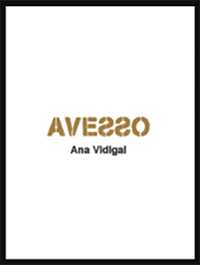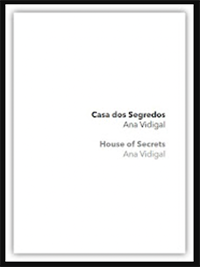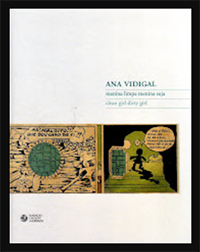 |
| (dedicado a quem gosta de fazer o numero da desgraçadinha) |
28.2.14
27.2.14
26.2.14
25.2.14
E o meu irmão Nuno, escreveu isto sobre mim: Nuno Vidigal, Ana’s younger brother, says,"The year before going to university, my mum suffered a serious car accident that left her disabled. During two years my sister was a nurse, a housewife, a mother and she was able to finish her degree in Painting and Fine Arts with distinction. She even exhibited in the meantime. When the situation stabilized, my sister left home to live on her own and started building her world. This is my sister.’"
Words by Maria Mota
This is a story about a painter who was born
during a dictatorship and raised in freedom,
Ana Vidigal, who has been painting for more
than thirty years. She paints what she is. Her
works are about memories, life, feelings, ideas
and love. She likes poetry, doing nothing,
and doesn’t hate anything because it is too
complicated to hate something. She is a
feminist at heart and is not afraid of saying or
painting what she thinks.
Ana lives and works in Alfama, one of the most traditional and ancient
neighborhoods in Lisbon – a neighborhood that says as much about Lisbon as it says about her. Her studio lies within her flat, which is filled
with handpicked details that happily face the river. Nothing is out of place.
Everything is so structured, but in an almost unpredictable way. This is
definitely the most beautiful house I have ever seen. The neatness of all the
furniture and crockery is evident and she fits perfectly in this scenery, just as
I had imagined, wearing a shirt, an old-school pair of jeans and holding two
pairs of glasses – an outfit that serves as her usual daily uniform.
Ana Vidigal, older sister of two boys, was born in 1960. Daughter of a
rather conservative family, Ana comes from a third generation of graduates.
Her father is an architect and her mother has the most beautiful job in the
world, being a mother. Her youth was marked by the Portuguese revolution
on 25 April 1974. She was thirteen at the time and this meant the end of a
lifestyle: the end of all the perks of a child of a schooled, nonpolitical family,
without any financial issues. It was the rise of new horizons. ‘The word
freedom, which had never got my attention, was now a goal to strive for. I
am part of the generation who became educated in freedom and this was
crucial to my future.’ Before 1974, she lived as if she were protected by a
bell jar. After that, following the Portuguese political and social revolution,
she kept living in the same bell jar, but her political awareness had started to grow. Ana’s mother was raised with the purpose of getting married and
having children, but Ana knew that after 1974 and whenever she became an adult, she would be able to do almost anything she wanted with her life.
Ana isn’t a mum. She is Ana. Nuno Vidigal, Ana’s younger brother, says,
‘The year before going to university, my mum suffered a serious car accident
that left her disabled. During two years my sister was a nurse, a housewife, a mother and she was able to finish her degree in Painting and Fine Arts
with distinction. She even exhibited in the meantime. When the situation
stabilized, my sister left home to live on her own and started building her
world. This is my sister.’
In the mid-1980s Ana decided to study painting. Although I thought this
wasn’t an obvious choice for a young Portuguese girl, Ana, in her groovy
way, replied that this was a very obvious choice indeed. She had no option.
That’s all she ever wanted to do and therefore all she could ever do. ‘Also, a
girl choosing an artistic career in Portugal wasn’t such a big issue that time.
There was still hope that a good marriage would help.’ I had hoped that she
would say something like this during our conversation because it entails
everything she is.
In the 1980s, Portugal was ruined in many ways, but also full of hope and
desires. However, the arts market had clearly been affected by the revolution.
Ana, among other artists of her generation, took part of the movement of
‘revaluation of painting in Portugal.’ Doing nothing but what they enjoyed
the most came as a response to a void. After 1974, many of the art galleries
were closed and the most interesting artists of the 1970s were out of the
country. ‘We followed the international movement of returning to painting.
I think it was all very intuitive; we wanted to paint and a public interest in
such work began to rise. It was nothing but knowing how to answer to the
moment and surviving doing what we enjoyed the most,’ explains Ana.
Painting was the speech Ana found to criticize the Portuguese society
without being ostentatious or propagandist, but by being naughty and
playful. Her paintings tell a lot not only about her memories, but also about
the world around her. She seeks, then she cuts and sticks. She was given
freedom and she took advantage of that. Her starting point is a memory. Ana
says, ‘Without memory there is no history or story. I paint, or glue, a time. I
can’t choose which time or place I like the most.’ I find it very curious how
hard it can be to separate herself from her work.
Madalena Vidigal, her niece, remembers how it was to go to Ana’s house
and share her imaginative life. Madalena says, ‘When I was young I used to
go to her place. I had a ticket to go into a magical world, her magical world.
The brushes, the paints, the clippings, the fabrics, the furniture, the props,
the photographs, they all had their own place. It was like visiting one of her
works of art, a series of fragments that represented her past and routine – a
place where creation seemed to merge with existence. Watching this process
was also like taking part in it and today I recognize myself in it. Sometimes I
even see myself in it.’ Whoever knows her work sees the characters that make
her stories, which in return create her personal history. Ana is especially
drawn to Anita, also known as Martine, a character from a children’s book
series. She says, ‘I have always enjoyed those books because of their stories
and drawings. Not only me but also other generations of children like me.
Later, I took ownership of the formal image of the girl to be able to mock my
own role as a woman in society. It’s like knowing how to laugh at myself.’
There are plenty of ways to write about her work, but I have chosen
to describe a couple of pieces from one of her best known exhibitions
and the one that puts it all together, Menina Limpa, Menina Suja or Clean
Girl, Dirty Girl in English. Featured in 2010, at Centro de Arte Moderna,
Fundação Calouste Gulbenkian, this exhibition is the perfect synthesis
of her thirty-year-long career, presenting her authorial universe, which is dispersed through the different techniques she uses to give life to her work.
Ana is a painter, but she does a lot more than just that. She experiments
with everything the world has to offer. Menina Limpa, Menina Suja is the
compilation of 120 pieces that reveal her life, memories, and country.
Ana says ‘Menina Limpa, Menina Suja is the title of a series of drawings I
made based on the children’s book series Sítio do Pica-Pau Amarelo written by
Monteiro Lobato, whose illustrations were created by Belmonte. In this series
there are always two girls, one is clean and the other is dirty.’ The exhibition’s
curator, Dr Isabel Carlos, says, ‘I decided to choose this title, not only because
this series had been selected for the exhibition, but also because it worked as
an analogy between the painting and the parallel work.’ If further analyzed,
this title also says much about her life as a girl educated to be clean who
ultimately had the chance to get dirty. Freedom can mean dirtiness if you
wish, even if a fine dirtiness.
The exhibition spans from the 1980s until the noughties and its route
starts with Domingo à Tarde (2000), or ‘Sunday Afternoon’ in English. It’s a
homemade video with a fixed plan of Ana’s face. She covered her face with
pushpins stuck on duct tape, covered her head with plastic bags, and then
closed them with tape and finally reflected her face in a deforming mirror –
a repelling performance that claims the attention of anyone passing by. One
year later, she used some stills from this video to create the piece, Tornei-me
Feminista para não ser Masoquista, which in English means ‘I became a feminist
to avoid becoming a masochist.’ The piece features a compilation of images
and sentences that say what she thinks about herself and men with a rather
sharp irony. Many of her pieces are based on a selection of literary sentences
taken out of context and inserted in her own world to create a new reality,
a new story.
One of the most iconic pieces featured in this exhibition is Penélope, a
bedcover created using the letters exchanged between her parents while her
father was in Guinea during the Colonial War. This piece was designed for
the exhibition Um Oceano Inteiro para Nadar (An Entire Ocean to Swim).
Ana had always wanted to explore the subject of the Colonial War because
she felt we had failed to speak about it at the time and probably everyone
from her generation had a father, an uncle, a cousin, or a brother who was
mobilized for this war. In her case, it was her father, who was thirty- years-
old at the time. The piece reflects the feelings of most Portuguese families in
the 1960s, who suffered destabilization, fear and nostalgia. She was only six
years old and her brothers were even younger, but the war meant the absence
of her father and the string of letters her mother received.
She never read the letters out of respect for her parents’ privacy but that
bedcover symbolizes not only the men mobilized to the war, but even more
the women who had to go through such a violent time away from the men
they loved, all alone, without knowing if they would ever come back. It
represents expectation and a long wait.
The Project Room – Void (2007) is another example of this specific time and the way Ana feels about it. It’s a recreation of her room during
the war. The walls and bedcovers are again covered with a selection of
pictures. There’s also a collection of baby bibs which support the pictures
displayed on the wall because her mother used to read the letters sent by
her father during dinner- time, while feeding her younger brothers. There’s
a severe crash between the aggression of the war and a feeling of absence,
tenderness, and affection between mother and children.
Also featured in this exhibition, among many other pieces, were a
couple of abstract paintings from the 1980s. They are not as mature or, at least, not as critical as her newest pieces, but they already reveal what
Ana would do from the 1990s onwards. Certainly, other pieces could be
described to reflect Ana’s profile but, all in all, her work is just like her. It’s
about incorporating, appropriating and reusing. It’s a continuous work of
research, but a fun research, and a deep look into the past, the present and,
in some cases, with an eye on the future. She takes texts and objects out of their context without taking away their meaning. On the contrary, she
twists them without meaning any harm but with all the honesty needed
for us to question them. Every piece has a specific meaning in her world
and a specific place in her timeline. All of them made sense at the time of
their creation and, in some way, made her who she is today. Her family and
youth surely have had a great influence in her work but no more than for
other people, yet perhaps her work allows Ana to explore it, while others
don’t have the chance to do so.
A sharp irony, a good selection of literary sentences, pictures, characters
and objects, an undeniable talent and a straightforward speech that makes
me feel unable to reply to her blunt remarks, summarize the work of this
artist. Ana’s path is not only marked by her paintings, but maybe even more by the time spent researching, opening boxes, trying, restarting, and
experimenting. Her lifelong friend, Teresa Goes Ferreira, says it best: Ana is, ‘A disciplined person, careful, hardworking, accurate in the use of words
and gestures. Her work is disciplinary, conveyed in a direct and personal
speech, and by adding elements she celebrates her pleasure in doing it.’
24.2.14
23.2.14
22.2.14
20.2.14
19.2.14
18.2.14
17.2.14
Subscrever:
Mensagens (Atom)




















































